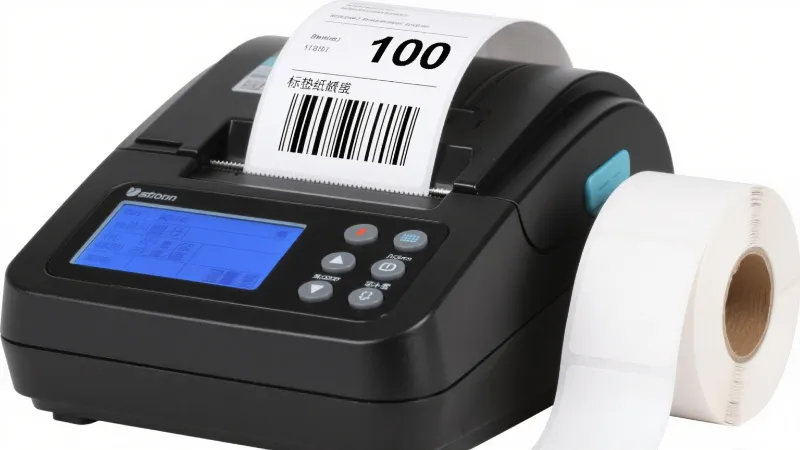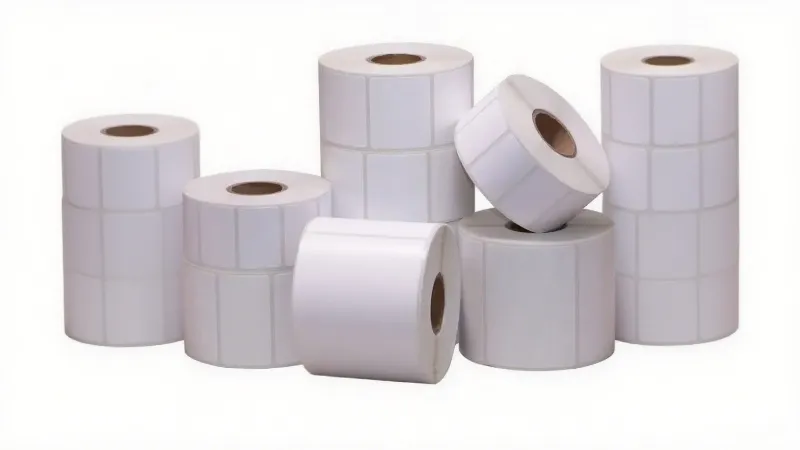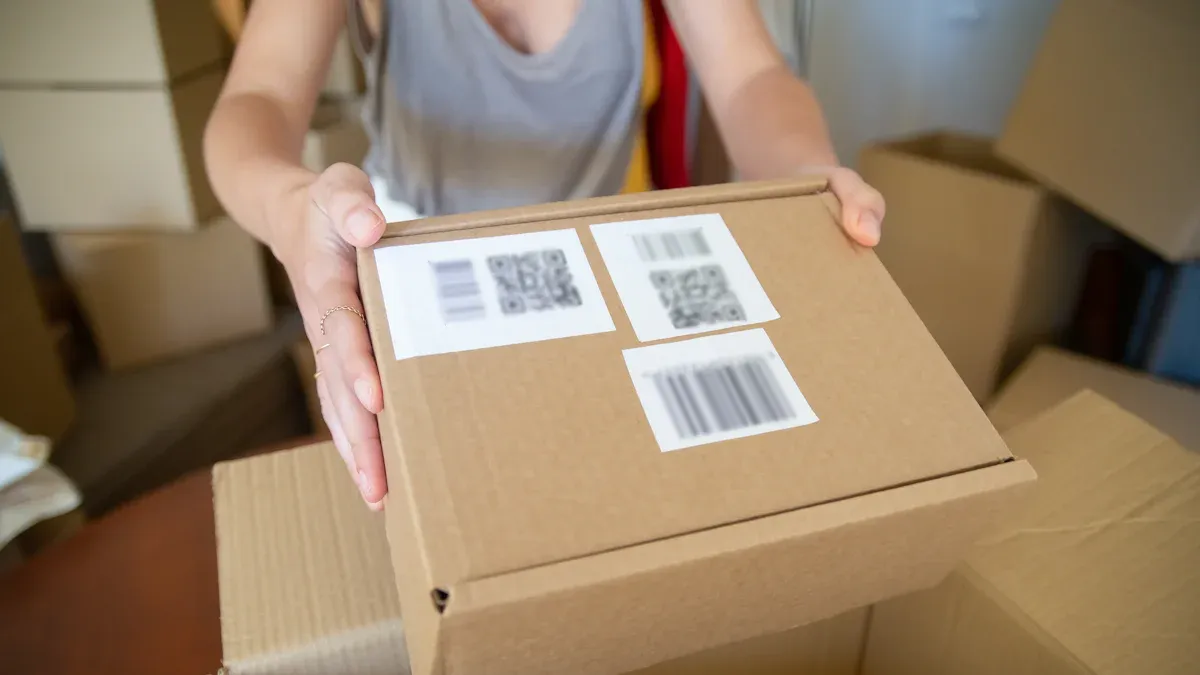
A direct thermal label has a special coating that reacts to heat. It makes pictures or words when it gets hot. You do not need ribbon, ink, or toner. This technology is different because it makes printing easier. It also helps cut down on waste. Many people and companies pick direct thermal labels for many reasons:
They save money because they do not need ribbon or ink.
Direct thermal printers usually cost less and are easier to care for.
The process helps people work faster by stopping less often.
These labels are best for short-term jobs, like shipping or barcodes.
More people want direct thermal labels in stores, shipping, and healthcare. This shows they are important in our busy world today.
Key Takeaways
Direct thermal labels use heat to make images. They do not need ink or ribbons. This makes printing easy and cheap.
These labels are best for short-term jobs like shipping, barcodes, and receipts. They can fade if they get hot, wet, or are in the sun.
Direct thermal printers are simple to take care of. They print fast and help businesses save time and money.
It is important to pick the right label material, size, and adhesive. This helps the label work well for the job and place.
Direct thermal labels are used a lot in shipping, stores, food service, and labs. They are good for quick, clear, and low-cost labeling.
Direct Thermal Label Basics

What Makes Them Unique
Direct thermal labels are special because they have a heat-sensitive coating. This coating changes when it gets hot. It makes words or pictures show up without using ink, toner, or ribbon. Most direct thermal printers use this method to make printing easy and quick. These labels are best for short jobs like shipping or barcodes.
The table below compares direct thermal labels and thermal transfer labels:
Component | Direct Thermal Labels | Thermal Transfer Labels |
|---|---|---|
Printing Method | Uses heat-sensitive material that darkens with heat; no ribbons or ink needed | Uses a ribbon coated with wax, resin, or both; heat melts ink onto label surface |
Material Composition | Heat-sensitive paper | Paper, polyester, polypropylene with ink from ribbon |
Durability | Susceptible to fading from heat, light, and friction | Durable, resistant to fading, heat, moisture, and chemicals |
Longevity | Limited; suitable for short-term use | Long-lasting; suitable for harsh environments |
Environmental Resistance | Low; not suitable for harsh conditions | High; withstands heat, moisture, chemicals |
Cost | Lower initial and ongoing costs; no ribbons required | Higher initial and ongoing costs due to ribbons and maintenance |
Maintenance | Simple; fewer components and less maintenance | More complex setup and maintenance due to ribbons and printer components |
Direct thermal labels cost less and are easier to care for. They do not need ribbons, so direct thermal printers are simpler than others. But these labels can fade if they get too much heat, light, or rubbing.
How They Work
Direct thermal labels have a coating that changes color with heat. The print head in the printer heats the label. The heat makes the coating react and turn dark. This creates the picture or words you want. No ink, toner, or ribbon is needed. This simple way of printing makes direct thermal printers easy to use and fix.
Direct thermal labels are best for short-term uses. The print can fade if it gets sunlight, heat, or water. That is why companies use these labels for shipping, receipts, or tags that do not last long.
Tip: You can use your fingernail to test a direct thermal label:
Direct thermal printers and labels make printing easy and save money. They are good for businesses that need fast, short-term labels. The special coating, no ribbons, and easy testing make direct thermal labels different from other types.
Label Features
Print Quality
Direct thermal labels make images that are easy to read. The print quality depends on a few things. Good thermal paper gives sharper prints that last longer. The printer’s settings, like heat and pressure, also matter. If the printhead gets too hot, the images can look too dark. If the pressure is not even, the print may look spotty. Cleaning the printhead often keeps the images clear and stops dust from causing trouble.
The table below lists important things that change print quality and how long it lasts:
Factor | Influence on Print Quality and Durability |
|---|---|
Quality of Thermal Paper | Sharper, more durable prints; resists fading |
Printhead Temperature | Too high or low causes unclear prints; proper calibration is essential |
Printhead Pressure | Uneven pressure leads to patchy or faded prints |
Environmental Factors | Heat, humidity, and light can cause fading or smudging |
Printer Maintenance | Regular cleaning ensures clear, consistent prints |
Direct thermal labels usually give clear images, but thermal transfer labels can make higher quality and last longer. For most short jobs, direct thermal labels are clear enough for barcodes, shipping, and receipts.
Durability and Shelf Life
Direct thermal labels are best for short-term labeling. How long they last depends on where and how they are used. Heat, sunlight, or water can make them fade, smudge, or turn yellow. Labels kept in cool, dry, and dark places last longer and keep their print.
Water and humidity can cause smudges and break down the label.
Special coatings or covers help protect labels from harm.
Handling labels gently helps them last longer.
Most direct thermal labels last about six months to one year if kept at room temperature (about 72°F) and 50% humidity. After this time, the sticky part and print may not work as well. Using sealed containers and keeping labels away from heat helps them stay good. Clean hands and gentle use stop dirt and damage.
Tip: Keep labels in a cool, dry place away from sunlight and heat so they stay in good shape for as long as possible.
Direct Thermal Labels: Uses

Common Applications
Direct thermal labels help with many daily tasks. You can find these labels on packages, products, and receipts. In shipping, workers use 4×6 direct thermal labels for addresses and tracking. Retail stores use them for barcodes, price tags, and shelf labels. Warehouses use these labels to keep track of items and mark products. Food service workers use direct thermal labels to show expiration dates and ingredients on containers. Laboratories use them to label samples and glassware.
Shipping and logistics: shipping labels, tracking barcodes, and address information
Retail: price tags, product labels, barcodes, and receipts
Warehousing: inventory labels and shelf tags
Food service: food rotation, storage containers, and expiration dates
Laboratories: sample identification and glassware labeling
Note: Direct thermal labels are best for short-term, indoor use. They make clear images that are easy to scan. But they can fade if they get too much heat, sunlight, or water.
Industry Examples
Many industries pick direct thermal labels because they are cheap and fast. Shipping companies print thousands of shipping labels every day. Retailers use these labels to change prices quickly and track items. Food service businesses use dissolvable direct thermal labels for food storage. These labels wash away in water and do not leave sticky stuff behind. Laboratories use freezer-grade direct thermal labels for samples that need to stay cold. The labels stay clear and stick well, even in cold or wet places.
The table below shows how different industries use direct thermal labels:
Industry | Typical Uses | Special Features |
|---|---|---|
Shipping | Shipping labels, tracking barcodes | Fast printing, cost-effective |
Retail | Clear barcodes, easy to scan | |
Food Service | Food rotation, storage, expiration dates | Dissolvable, freezer-safe options |
Laboratories | Sample and glassware labeling | Freezer-grade, moisture resistant |
Direct thermal labels are a simple way to label things for a short time. They are cheap and easy to use, so busy places like them a lot.
Pros and Cons
Advantages
Direct thermal labels have many good points for people and businesses. They are great when you need labels fast and that work well. These labels are best for short jobs like shipping, stores, and hospitals. Here are some main good things:
You do not need ink, toner, or ribbons. This saves money and makes less trash.
Labels print fast, so they are good when you need lots of labels quickly.
The printing makes sharp and clear pictures. This helps people read barcodes and addresses.
Direct thermal printers have fewer parts. They do not break as much and need less fixing.
The way they work is simple. Workers can use the printers without trouble.
Buying many labels at once makes each label cheaper. This makes them cost less than thermal transfer labels.
The table below shows how much each label costs for both types:
Labeling Technology | Consumables Required | Cost per Label (approx.) | Notes on Bulk Purchasing and Cost Impact |
|---|---|---|---|
Direct Thermal | Thermal paper only | No ink or ribbons needed; bulk discounts available | |
Thermal Transfer | Thermal ribbons + label stock | $0.15 – $0.65 | Higher consumable cost; less cost-effective in bulk |
💡 Tip: Direct thermal labels help the environment. They make less waste and use fewer chemicals.
Limitations
Direct thermal labels also have some problems. They do not work for every job. Here are the main bad things:
Labels can fade or turn dark if they get heat, light, rubbing, or water.
They do not last long, so they are not good for things you need to keep for a long time.
These labels do not work well outside or in tough places.
If the label gets sunlight or heat for too long, you might not be able to read it.
Most direct thermal labels are made of paper. They are not waterproof or weatherproof like some thermal transfer labels.
If you need labels to last a long time or be outside, thermal transfer labels are better.
⚠️ Note: Direct thermal labels are best for inside use. They work well when you only need the label for a short time.
Choosing Labels
Factors to Consider
Picking the right labels means knowing about materials and adhesives. Paper labels are good for short-term use inside. They can look shiny or dull but do not handle water or scratching well. Polyester labels are very strong. They resist chemicals, water, and scratching. These labels work outside or in tough places but cost more money. Polypropylene labels are strong and not too expensive. They are great for shipping and warehouses. Vinyl labels bend easily and can handle hot, cold, and sunlight. This makes them good for outside use.
The type of adhesive is important too. Permanent adhesives keep labels stuck for a long time. Removable adhesives let you take labels off without sticky mess. The right adhesive helps labels stay on in different weather and wet places. Label size matters for printers and for reading or scanning. Printers need the right size to stop jams and print clearly.
Where you use labels is also important. Heat, sun, or chemicals can make labels fade or fall off. Keeping labels in cool, dry places helps them last longer. Some jobs need BPA-free labels, like food or health care.
🌱 Tip: Eco-friendly direct thermal labels made from recycled stuff help the planet. They work like regular labels but are not as strong as thermal transfer labels.
Matching to Needs
Businesses should pick labels that fit their needs. For shipping, 4×6 labels fit most direct thermal printers. They have enough space for barcodes and addresses. Stores use smaller labels for prices or shelves. Warehouses need strong labels that do not get ruined by water or scratching.
Direct thermal printers are best for short-term, indoor labels. If labels need to last longer or go in tough places, thermal transfer labels are better. Always check if the label fits your printer before buying. Special labels, like waterproof or freezer ones, help in special places.
📋 Note: Picking the right label material, adhesive, and size helps labels work well and cuts down on waste.
A direct thermal label has a special coating that reacts to heat. It makes pictures or words without using ink or ribbons. These labels are easy to use and do not cost much. They are good for short jobs like shipping or keeping track of items. Before picking a label, businesses should think about how long it needs to last and where it will be used. Direct thermal labels are a smart choice when you need fast and cheap labels. Always pick the right label for the job to get the best results.
FAQ
What is the main difference between direct thermal and thermal transfer labels?
Direct thermal labels use special paper that changes with heat. Thermal transfer labels use a ribbon to put ink on the label. Direct thermal labels are best for short-term jobs. Thermal transfer labels last longer and can handle tough places.
Can direct thermal labels go in the freezer?
Some direct thermal labels have coatings for freezer use. These freezer-grade labels stay sticky and easy to read in cold. Regular direct thermal labels might not work well in freezing places.
How can someone tell if a label is direct thermal?
You can do a scratch test. Rub your fingernail on the label. If you see a black mark, it is direct thermal. If nothing happens, it is probably a thermal transfer label.
Are direct thermal labels safe for food packaging?
Many direct thermal labels are safe for food that does not touch them. Some labels are BPA-free and follow food safety rules. Always check the label details or ask the seller for food-safe choices.
